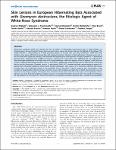Skin Lesions in European Hibernating Bats Associated with Geomyces destructans, the Etiologic Agent of White-Nose Syndrome
Wibbelt, Gudrun
Puechmaille, Sébastien J.
Ohlendorf, Bernd
Mühldorfer, Kristin
Bosch, Thijs
Görföl, Tamás
Passior, Karsten
Kurth, Andreas
Lacremans, Daniel
Forget, Frédéric
White-nose syndrome (WNS) has claimed the lives of millions of hibernating insectivorous bats in North America. Its etiologic agent, the psychrophilic fungus Geomyces destructans, causes skin lesions that are the hallmark of the disease. The fungal infection is characterized by a white powdery growth on muzzle, ears and wing membranes. While WNS may threaten some species of North American bats with regional extinction, infection in hibernating bats in Europe seems not to be associated with significant mortality. We performed histopathological investigations on biopsy samples of 11 hibernating European bats, originating from 4 different countries, colonized by G. destructans. One additional bat was euthanized to allow thorough examination of multiple strips of its wing membranes. Molecular analyses of touch imprints, swabs and skin samples confirmed that fungal structures were G. destructans. Additionally, archived field notes on hibernacula monitoring data in the Harz Mountains, Germany, over an 11-year period (2000–2011) revealed multiple capture-recapture events of 8 banded bats repeatedly displaying characteristic fungal colonization. Skin lesions of G. destructans-affected hibernating European bats are intriguingly similar to the epidermal lesions described in North American bats. Nevertheless, deep invasion of fungal hyphae into the dermal connective tissue with resulting ulceration like in North American bats was not observed in the biopsy samples of European bats; all lesions found were restricted to the layers of the epidermis and its adnexae. Two bats had mild epidermal cupping erosions as described for North American bats. The possible mechanisms for any difference in outcomes of G. destructans infection in European and North American bats still need to be elucidated.
Dateien zu dieser Publikation
Keine Lizenzangabe

